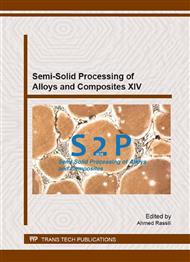[1]
D.H. Kirkwood. Semisolid metal processing, Int. Mater. Rev. 39 (1994) 173-189.
Google Scholar
[2]
H.V. Atkinson. Semisolid processing of metallic materials, Mater. Sci. Technol. 26 (2010) 14011413.
Google Scholar
[3]
S.P. Midson. Industrial Applications for Aluminum Semi-Solid Castings, Solid State Phenom. 217 (2014). 487-495.
DOI: 10.4028/www.scientific.net/ssp.217-218.487
Google Scholar
[4]
D.H. Kirkwood, M. Suéry, P. Kapranos, H.V. Atkinson, K.P. Young. Modeling of Semisolid Processing. Semi-solid Processing of Alloys. Springer, 2010. pp.71-99.
DOI: 10.1007/978-3-642-00706-4_7
Google Scholar
[5]
A. Neag, V. Favier, R. Bigot, H.V. Atkinson. Comparison between numerical simulation of semisolid flow into a die using FORGE© and in situ visualization using a transparent sided die, Journal of Materials Processing Technology 229 (2016) 338-348.
DOI: 10.1016/j.jmatprotec.2015.09.035
Google Scholar
[6]
F. Zhang, X.G. Hu, D.Q. Li, Y.F. He, X.J. Xu, Q. Zhu. Simulation on the Thixocasting Process of the Turbocharger Impellers and Selection of the Viscosity Models. Solid State Phenomena, vol. 217: Trans Tech Publ, 2015. 219-224.
DOI: 10.4028/www.scientific.net/ssp.217-218.219
Google Scholar
[7]
X.G. Hu, F. Zhang, Y.F. He, S.P. Midson, Q. Zhu. Experimental Study and Numerical Simulation on the Blistering Defect during Thixocasting. Solid State Phenomena, vol. 217: Trans Tech Publ, 2015. 144-150.
DOI: 10.4028/www.scientific.net/ssp.217-218.144
Google Scholar
[8]
C.G. Kang, S.M. Lee, B.M. Kim. A study of die design of semi-solid die casting according to gate shape and solid fraction, Journal of materials processing technology 204 (2008) 8-21.
DOI: 10.1016/j.jmatprotec.2008.01.038
Google Scholar
[9]
L. Orgéas, Z. Idris, C. Geindreau, J.F. Bloch, J.L. Auriault. Modelling the flow of power-law fluids through anisotropic porous media at low-pore Reynolds number, Chem. Eng. Sci. 61 (2006) 4490-4502.
DOI: 10.1016/j.ces.2006.01.046
Google Scholar
[10]
M. Hufschmidt, M. Modigell, J. Petera. Modelling and simulation of forming processes of metallic suspensions under non-isothermal conditions, J. Non-Newtonian Fluid Mech. 134 (2006) 16-26.
DOI: 10.1016/j.jnnfm.2005.10.006
Google Scholar
[11]
T.Y. Liu, H.V. Atkinson, P. Kapranos, D.H. Kirkwood, S. Hogg. Rapid compression of aluminum alloys and its relationship to thixoformability, Metall. Mater. Trans. A 34 (2003) 15451554.
DOI: 10.1007/s11661-003-0266-y
Google Scholar
[12]
C. Quaak: Ph. D Thesis, Technische Univesiteit Delft, Delft, The Netherlands, (1996).
Google Scholar
[13]
T. Liu, H. Atkinson, P. Kapranos, D. Kirkwood, S. Hogg. Rapid compression of aluminum alloys and its relationship to thixoformability, Metall. Mater. Trans. A 34 (2003) 1545-1554.
DOI: 10.1007/s11661-003-0266-y
Google Scholar
[14]
M. Syamlal, W. Rogers, T.J. O'Brien. MFIX documentation: Theory guide, National Energy Technology Laboratory, Department of Energy, Technical Note DOE/METC-95/1013 and NTIS/DE95000031 (1993).
DOI: 10.2172/10145548
Google Scholar
[15]
D.G. Schaeffer. Instability in the evolution equations describing incompressible granular flow, Journal of differential equations 66 (1987) 19-50.
DOI: 10.1016/0022-0396(87)90038-6
Google Scholar
[16]
Ansys Fluent theory guide, ANSYS Inc., USA (2011).
Google Scholar
[17]
D. Gidaspow, R. Bezburuah, J. Ding. Hydrodynamics of circulating fluidized beds: kinetic theory approach. Illinois Inst. of Tech., Chicago, IL (United States). Dept. of Chemical Engineering, (1991).
Google Scholar
[18]
H.I. Laukli, C.M. Gourlay, A.K. Dahle. Migration of crystals during the filling of semi-solid castings, Metallurgical and Materials Transactions A 36 (2005) 805-818.
DOI: 10.1007/s11661-005-0195-z
Google Scholar


